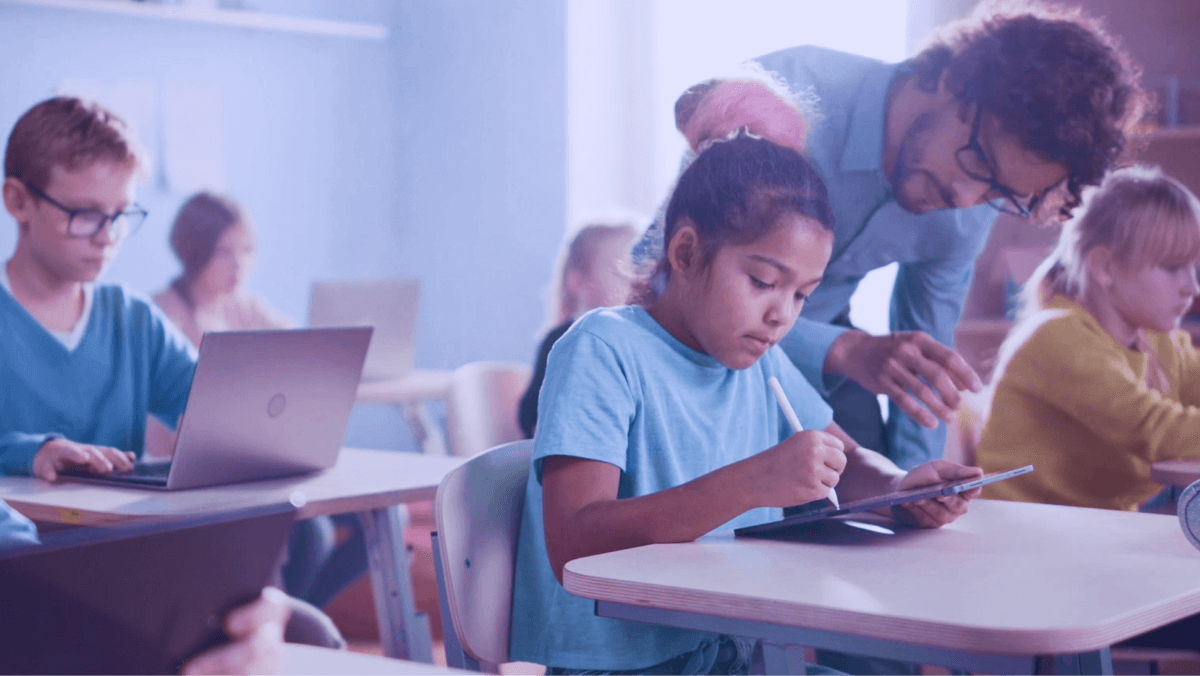At the start of the COVID-19 pandemic, many countries imposed lockdowns that resulted in schools closing for several months.
However, not all countries hit by the pandemic closed all of their schools. For example, according to a report on the impact of covid 19 on education insights education at a glance, primary schools in Iceland remained open if class sizes were below 20 students.
In Sweden, most primary and lower secondary schools remained open, while upper secondary schools switched to mainly distance learning from mid-March 2020. No matter how different schools and countries reacted to the imposed lockdown and restrictions, the increase in mobile devices in K-12 schools all around the world is undeniable.
Having access to internet-connected devices became a requirement for students to effectively engage in their new learning environments.
Let’s take a journey back to the beginning of the pandemic.

How schools continued learning despite school closure
To start off, schools and parents had to come up with an urgent response to the pandemic with ways that students could continue with their classes.
Access to resources played a large role in the measures that were taken by different schools and parents around the world. Unfortunately, not all students were in a position to take advantage of remote and online classrooms. This exclusion would be the case for a higher percentage of students from lower-income households.
In order to support student learning, schools chose a variety of resources while students were unable to come to school.
Some of these resources included instructional packages (textbooks, worksheets and printouts), radio education, educational television and online instructional resources, while other schools opted to expand upon an already existing device-oriented strategy. This was done to make sure each and every student had a device to take home, increasing the number of mobile devices in K-12 schools.
Online instructional resources ranged from educational content that students could explore at their own discretion and formalised learning programmes conducted at their own pace, to real-time lessons led by their teachers using the virtual classroom.
According to an article on Edweek Market Brief, K-12 mobile device demand has skyrocketed over the last few years. The estimated number of devices delivered worldwide to K-12 schools in 2019 was around 30 million.
Early in 2020, it was estimated that 36 million K-12 devices would be delivered to schools around the world. However, by the end of 2020, a reported 51 million tablets and laptops were delivered to K-12 schools around the world. A far cry from the original estimate of 36 million.
eLearning statistics 2022 estimates that from the Year 2020 to 2024, the US eLearning Market Will Expand by $12.81 Billion.
In December 2019, device penetration in K-12 schools was just under 60 percent and was thought to be far from complete device saturation at the K-12 level. In the last year, this number has increased to nearly 80 percent, with the market heading towards complete saturation in a few years’ time.

2020 saw a rise in computer purchases in households too. According to a report by The National Center for Education Statistics, 88 percent of adults who had children under 18 in the home enrolled in the school reported that computers were always or usually available for educational purposes.
In just over a year, by the end of March 2021, the percentage of computers for educational purposes in households increased to 94 percent.
An impressive final percentage for learning, however the digital divide in developing countries around the world was incomparable due to a lack of resources and funding.
According to Unicef, around 60 percent of the world’s population is now online, but most of those people are in developed countries.
In comparison, the digital divide in developing countries around the world was incomparable due to a lack of resources and funding. As of July 2021, only one in five people are online in the less-developed countries.
The Impact of Mobile Devices on the World of Education
The continued increase of mobile devices in K–12 schools can be seen as both an advantage and disadvantage for students and teachers.
This is because while having mobile devices has allowed schools to expand the classroom and continue with learning during the pandemic, they also provide students more opportunities to access inappropriate and distracting online content, as well as increase the number of potential network vulnerabilities.
Previously, schools could have simply banned personal smartphones and devices from the classroom to mitigate the risks that come with them, however, with the use of devices for learning, and the increased prevalence of BYOD programs, the current state of the modern classroom makes this solution a lot harder to navigate.
Digital technology continues to offer new possibilities to the world of education.
Together with teachers, smart digital learning systems do not just educate students, but can simultaneously observe how they study, the tasks that interest them, as well as the problems that they find to be difficult.
This insight into learning creates incredible opportunities for intervention and assistance from teachers. Communication between students and teachers is always the first prize, however, in instances where students aren’t coming forth or a conversation with the student doesn’t reveal any issues, teachers are able to clearly identify areas of concern and assist their students in an appropriate manner.
Similarly, digital learning can give students the opportunity to design and learn from experiments, and see challenging concepts in action, rather than just learning about them.
An example of this could be the combustion engine, and clearly seeing how the engine works visually.

Benefiting from Technology in K-12 Schools
It is crucial now more than ever, that schools understand what the prevalence of mobile devices and increased digitalization of education means for the modern classroom.
With the array of tools and resources available online, educators continuously apply themselves to learn more about digital technology and how to best benefit from the increase in mobile devices in K-12 schools.
This may include coming up with new forms of learning to promote spontaneous collaboration and providing personalised learning experiences that are provided by online tools while finding a balance with traditional forms of education.
A crucial part of the ‘old traditional learning methods’ that is possibly even more important now than ever is regular communication, conversation and relationship building between students and teachers.
You can read my previous article on prioritising students’ well-being in the digital classroom, and find out more about how to invigorate connection in increasingly digital classrooms, which I discovered from my conversation with Steven Bollar, an EdTech superhero and educational thought leader.
My article discusses the importance of student well-being and how to better relationships with students while using technology in the classroom.
In my interview with Steven Bollar, we discuss some tried and tested tips to invigorate connection in increasingly digital classrooms.
Living and Learning with Digital Technology
Remote learning became a lifeline for education during the pandemic, but the opportunities that digital technologies offer are not just a temporary solution during a crisis.
K–12 students and teachers rely heavily on mobile devices for learning and teaching. This means school leaders need solutions to manage these challenges and assist educators to get the best out of their increasingly digital learning environments.
Remote learning can also mean students often feel isolated. Which requires teachers to develop strategies to incorporate the missing human element in the digital classroom that are normally present in a traditional classroom.
It’s important to always continue learning about new developments in the modern classroom, and how to best utilise these ever-evolving digital technologies.
If you have any thoughts on this or methods that you use yourself, feel free to contact us here, I’d love to hear about them.
Onwards,
Panashe Goteka
Team Mobile Guardian






